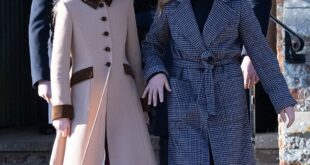The Palace Papers
Tina Brown Century £20
Way back in 1955, when the author of The Palace Papers was a toddler, the venerable writer and TV personality Malcolm Muggeridge warned that the Royal Family was in danger of going off the rails.
‘The whole show is utterly out of hand,’ he wrote in The New Statesman, adding that much of the publicity around them was, in all likelihood, generated by their own appetites.
‘I suspect that they develop a taste for the publicity which, in theory, they find so repugnant. This is merely human. It applies in one form or another to everyone.

In 2019, The Queen (above) captained one of the Sandringham’s Women’s Institute teams playing a version of Pointless, which is, we are told, one of her favourite television shows
‘Even a tiny television notoriety is liable to please, or at any rate excite, when all one’s conscious being finds it vulgar and odious.
‘At the same time, the Royal Family ought to be properly advised on how to prevent themselves and their lives from becoming a sort of royal soap opera.’
Sixty-seven years later, there is now no ‘sort of’ about it: the House of Windsor is the world’s leading soap opera, with any number of long-running franchises and offshoots, among them The Crown on Netflix, for those who like melodrama, and The Windsors on Channel 4, for those who prefer comedy.
Fittingly, the cover of The Palace Papers resembles the opening sequences of Dallas or Dynasty, with the determinedly unsmiling faces of the female principals – Camilla, the Queen, Kate and Meghan – in four thin rectangles, side by side.
‘Inside the House of Windsor – the Truth and the Turmoil,’ reads the breathless subheading.
Tina Brown tells the story of the past 25 years of the House of Windsor in suitably excitable, schlocky prose, full of words and metaphors more usually found in airport blockbusters by Andy McNab or Lee Child: bombs, explosions, and hand grenades.
In the very first paragraph, Brown writes of Meghan’s ‘nuclear revelations’ to Oprah Winfrey, on the next page she tells us that ‘it was kryptonite’.
On page five we hear that Princess Diana’s global fame ‘hit Buckingham Palace like a meteor. Her heat singed the Queen’s tiara.’
Later, we hear that Diana’s ‘bomb-throwing instincts towards Charles…splattered the monarchy’ and that her death set off a ‘tsunami of grief’. In turn, Earl Spencer’s eulogy was ‘a hand grenade’ that ‘kicked the frozen-faced Royal Family in the teeth.’
Even the postponement of Charles and Camilla’s wedding by just one day, due to the funeral of Pope John Paul II, was, in Brown’s view, a ‘cosmic eruption’ that caused Camilla to go into ‘meltdown’.
This is a shame, because Brown is a busy bee, with plenty of good contacts, and The Palace Papers has a great deal of fresh material. But her prose adds a layer of make-believe to even the trustiest revelation, as well as stifling nuance and subtlety.
All the key episodes of the ever-expanding Royal soap opera are covered – the Fake Sheikh, Philip’s gaffes, the trial of Paul Burrell, Major Ron, James Hewitt, Ardent TV, toe-sucking, Harry in Nazi fancy dress, Waity Katie and Andrew’s appearance on Newsnight (which prompted the witty New York Post headline ‘His Royal Dryness’).
It is almost as though, over the years, Royal scandals have expanded to fill all the available paper.
As well as humming along to the old, familiar tunes, I learned hundreds of things that were new to me. Did you know that, after the Parker Bowles divorce, their house was bought by Nick Mason, the drummer with Pink Floyd?
Or that Diana’s butler, Paul Burrell, had so many affairs with guardsmen that Diana’s chef knew him as ‘Barrack-Room Bertha’?
On a milder level, I had no idea that over the course of 70 years the Queen has only four times missed her annual visit to the Sandringham chapter of the Women’s Institute; in 2019 she captained one of their teams playing a version of Pointless, which is, we are told, one of her favourite television shows.
And so it goes on, most of the tales being, as one might expect, rather less cosy.
Apparently, William and Harry were both troublesome youngsters: at nursery school, William was so boisterous that he was known as Basher Wills and, at Eton, Harry ‘regularly got into fights that turned physical, ending up on crutches after kicking in a window during a dispute with another student over a girl’.
One of Brown’s many unnamed sources is an American media executive who visited the Duchess of York at Royal Lodge in 2015 to discuss a project.
‘“We were having lunch,” the media executive told me, “and Andrew came in and sat down and said to me, ‘What are you doing with this fat cow?’ I was so stunned at his level of sadism. I thought, ‘What an asshole.’ She has to sing for her supper. She’s afraid of him.”’
Her portrait of Andrew is the most damning of all; he is, if you will, the J.R. or Dirty Den of the Windsors, by turns bossy, entitled and thick, known as HRB or His Royal Buffoon to the diplomatic community.
Brown’s New York contacts have given her plenty of believable dirt on the Duke’s friendship with Jeffrey Epstein. She claims he stayed with Epstein so often in New York that he had his own private suite.
‘Privately, Epstein told people that Andrew was an idiot, but – to him – a useful one…Epstein confided to a friend that he used to fly the Duke of York to obscure foreign markets where governments were obliged to receive him, and Epstein went along for the ride as HRH’s investment adviser.
‘With Andrew as frontman, Epstein would negotiate deals with these (often) shady players and give Andrew some cream off the cake.’
And, for all Brown’s red-top bombast, she can be witty, too.
At one point she suggests that Andrew exhibits symptoms of ‘the Dunning-Kruger effect’, which she describes as ‘the cognitive bias in which people come to believe that they are smarter and more capable than they really are.
The combination of minimal self-awareness and dim intellectual wattage leads sufferers of this condition to overestimate their own capabilities.’
How many of the stories in this book can one believe? For the most part they strike me as having the ring of truth, particularly where Harry and Meghan are concerned.
But every now and then comes a bit of gossip that is so transparently ludicrous that it makes one question all the rest. For instance, on page 34 she says that, in his initial courtship of Camilla, Charles ‘clearly appreciated her sexual joie de vivre.
‘“Pretend I am a rocking horse,” she is said to have urged him, to conquer his early diffidence in bed.’
Where did this story come from? It doesn’t strike me as the kind of juicy snippet Camilla or Charles would have passed on to any of their friends, and they certainly wouldn’t have told Tina Brown.
So where did she get it? At the back of The Palace Papers there are 42 pages of ‘Notes’, with references for key quotes.
I looked up page 34 and found that the source for the rocking-horse quote is none other than the ludicrous Kitty Kelley, whose 1997 book The Royals was accurately condemned as ‘a breathtaking, audacious practical joke’ by the historian Professor Ben Pimlott.
One of the people Kelley lists as a valuable source for the information in her book is ‘Talbot Church, an author who acknowledged many hours of informal interviews with the Duke and Duchess of York for his book The Royal Love Birds.’
In fact, Talbot Church, ‘the man the Royals trust’, was a silly name invented by my late friend, the satirist Willie Donaldson, aka Henry Root, whose book was a spoof on hack Royal writers like Kelley.
With so much fantasy surrounding the Royal Family, it was inevitable that some of their own members would become willing fabricators of their own storylines.
Of Harry and Meghan, Brown concludes, ‘They were both now drunk on a shared fantasy of being the instruments of global transformation.’
What will happen next? To find out, tune in to the next episode…
Source link



